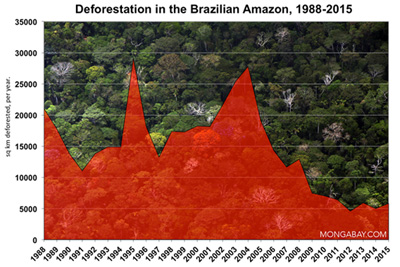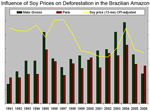Amazon deforestation forecast for 2008 revised downward
Amazon deforestation forecast for 2008 revised downward
mongabay.com
July 17, 2008
|
|
Deforestation in the Brazilian Amazon fell sharply in the month of May (1096 square kilometers) compared to May a year-ago (1222 square kilometers), according to preliminary satellite data announced by the country’s environment minister on Tuesday.
Brazilian Environment Minister Carlos Minc said a preliminary analysis by the government’s National Space Research Institute (INPE) showed 1,096 square kilometers (423 square miles) of rain forest were cut down in May, down from 1,123 square kilometers (434 square miles) in April. Most of the clearing continued to be in the so-called “Arc of Deforestation”, states that lie in Brazil’s fast-expanding agricultural frontier. Large tracts of forest are logged and then burned for cattle pasture. Existing pasture is increasingly converted for giant mechanized soy farms.
 Brazil accounted for nearly half of global tropical forest loss between 2000 and 2005. |
While the month-by-month satellite data are notoriously unreliable and largely meaningless due to cloud cover (53 percent of the forest area in the most recent images was obscured) and seasonal fluctuations in forest clearing, at a press conference in Brazilian Environment Minister Carlos Minc felt confident enough in the numbers to reduce his forecast for Amazon rainforest loss for the August 2007 – July 2008 year to 13,000 square kilometers (5,000 square miles). Previous estimates projected annual forest clearing to reach 14,000-15,000 square kilometers (5,400-5,800 square miles). Last year 11,224 square kilometers (4,334 square miles) of Amazon forest were cleared.
The Brazilian Amazon consists of about 4.1 million square kilometers, of which about 3.4 million are forested. Until the second half of last year when fires and forest clearing spiked, deforestation had been declining since reaching a peak in 2004. The recent jump in deforestation has been attributed to surging prices for commodities produced in the Amazon region.
Palm oil industry moves into the Amazon rainforest
(7/9/2008) Malaysia’s Land Development Authority FELDA has announced plans to immediately establish 100,000 hectares (250,000) of oil palm plantations in the Brazilian Amazon. The agency will partner with Braspalma, a local company, to form Felda Global Ventures Brazil Sdn Bhd. FELDA will have a 70 percent stake in the venture. The announcement had been expected. Last month Najib said Malaysia would seek to expand its booming palm oil industry overseas. The country is facing land constraints at home.
Global Commodities Boom Fuels New Assault on Amazon
(6/20/2008) With soaring prices for agricultural goods and new demand for biofuels, the clearing of the world’s largest rain forest has accelerated dramatically. Unless forceful measures are taken, half of the Brazilian Amazon could be cut, burned or dried out within 20 years.
Brazil’s environmental minister resigns after losing Amazon fight
(5/14/2008) Marina Silva, Brazil’s environmental minister, resigned Tuesday after losing several key battles in her fight to rein in destruction of the Amazon rainforest.
7000 sq km of Amazon rainforest destroyed in late 2007 says Greenpeace
(1/25/2008) Brazilian government figures will likely show that more than 7,000 square kilometers of Amazon rainforest were destroyed between August and the end December 2007, said environmental group Greenpeace.
Amazon deforestation jumps in the second half of 2007
(1/24/2008) Deforestation in the Brazilian Amazon rose sharply in the second half of 2007 as a result of surging prices for beef and grain, said a top Brazilian environmental official.
 |
2007 Amazon fires among worst ever
(10/22/2007) By some measures, forest fires in the Amazon are at near-record levels, according to analysis Brazilian satellite data by mongabay.com. A surge in soy and cattle prices may be contributing to an increase in deforestation since last year. Last year environmentalists and the Brazilian government heralded a sharp fall in deforestation rates, the third consecutive annual decline after a peak in 2004. Forest loss in the 2006-2007 season was the lowest since record-keeping began in the late in 1970s. While the government tried to claim credit for the drop, analysts at the time said that commodity prices were a more likely driver of slow down: both cattle and soy prices had declined significantly over the previous months.
Is the Amazon more valuable for carbon offsets than cattle or soy?
(10/17/2007) After a steep drop in deforestation rates since 2004, widespread fires in the Brazilian Amazon (September and October 2007) suggest that forest clearing may increase this year. All told, since 2000 Brazil has lost more than 60,000 square miles (150,000 square kilometers) of rainforest — an area larger than the state of Georgia or the country of Bangladesh. Most of this destruction has been driven by clearing for cattle pasture and agriculture, often in association with infrastructure development and improvements. Higher commodity prices, especially for beef and soy, have further spurred forest conversion in the region. While drivers of Amazon deforestation are stronger than ever, mounting concerns over climate change and the effort to reign in greenhouse gas emissions may provide new economic incentives for landowners to preserve forest lands through a concept known as “avoided deforestation”.